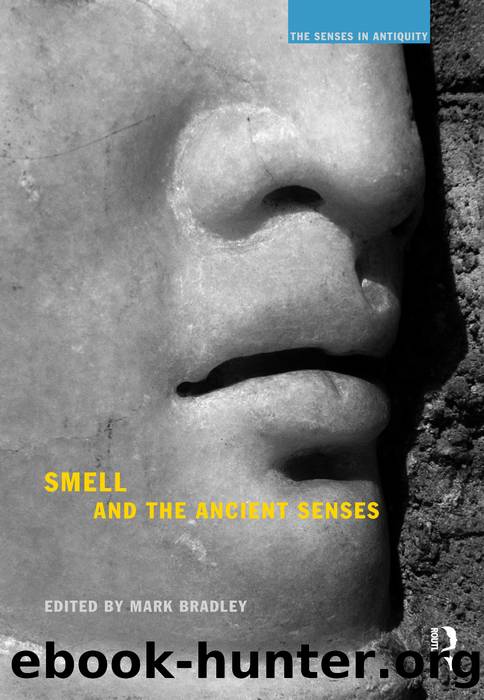Smell and the Ancient Senses by Unknown

Author:Unknown
Language: eng
Format: epub
ISBN: 978-1-317-56581-9
Publisher: Taylor & Francis (CAM)
Figure 6.9 Stabian Baths at Pompeii (VII.1.8.15–17.50–51), female section, caldarium tub. Photo: A. Koloski-Ostrow.
While the plays, slapstick skits and readings held in theatres did not have occasion to raise the stink of the amphitheatres, the sale of cheap foodstuffs and the sweat of performances held in the heat of the morning generated powerful smells. The oldest types of stage show were apparently quite vulgar, displaying nudity, violence, sex and the real or imagined smells from loud burbs and louder bursts of flatulence.
Furthermore, shopping for meat or vegetables in an open Roman market would have had its attractions for the nose, but not every aspect of the market would have supplied pleasant smells. Crowded Roman food markets, usually located just adjacent to city’s forum, certainly provided a wide array of lovely smells from crisp, bright-coloured root vegetables, bunches of green herbs, dried and fresh fruits, and spices. The shellfish, pungent piles of fish and blood-red slabs of meat – often sold in a circular stand in the middle of the market – had no refrigeration for hours at a time, save for some occasional ice or snow from the mountains in the winter months. This fish and meat must have often been fly-infested in warmer weather and would have quickly turned rancid, even before the food could reach the Roman kitchens in which it would be prepared for dinner. As I noted, the heavy and savoury fish sauces, like garum, probably covered up a multitude of stomach-churning problems posed by deteriorating foods.
Our modern idea of religion providing peace and contemplation must be shattered in the realm of Roman temples and shrines, as smell must have provided a major distraction there (for one interpretation of Greek ritual smells, see Clements, this volume). Rituals were held outside in the heat of the day and were, like gladiatorial or animal games in the amphitheatre, drenched in blood sacrifice and the strong smells of death. Every festival day – dozens during the annual cycle of the Roman calendar – required a blood sacrifice of at least one, and sometimes hundreds, of bulls or other animals killed before a standing-room-only crowd. The smoke and smell of fat burning on open altars must have filled the forum and nearby streets with regularity (Figure 6.10). In the crowded public venues of fora with their temples and public food markets, the ever-present and succulent odours of burning sacrifice for religious piety mixed with the sweet fruits of the Roman countryside, while these smells in turn mixed with the stench of death from nearby butcher shops or the parade of dead animals from the amphitheatre.
Download
This site does not store any files on its server. We only index and link to content provided by other sites. Please contact the content providers to delete copyright contents if any and email us, we'll remove relevant links or contents immediately.
The Five People You Meet in Heaven by Mitch Albom(3520)
The Secret Power of Speaking God's Word by Joyce Meyer(3067)
Real Sex by Lauren F. Winner(2986)
Name Book, The: Over 10,000 Names--Their Meanings, Origins, and Spiritual Significance by Astoria Dorothy(2960)
The Holy Spirit by Billy Graham(2914)
0041152001443424520 .pdf by Unknown(2812)
How The Mind Works by Steven Pinker(2776)
ESV Study Bible by Crossway(2758)
Ancient Worlds by Michael Scott(2649)
Churchill by Paul Johnson(2543)
The Meaning of the Library by unknow(2533)
The ESV Study Bible by Crossway Bibles(2528)
The Gnostic Gospels by Pagels Elaine(2496)
MOSES THE EGYPTIAN by Jan Assmann(2394)
Jesus by Paul Johnson(2330)
City of Stairs by Robert Jackson Bennett(2328)
The Complete Dead Sea Scrolls in English (7th Edition) (Penguin Classics) by Geza Vermes(2258)
Ancient Near Eastern Thought and the Old Testament by John H. Walton(2205)
The Nativity by Geza Vermes(2202)
